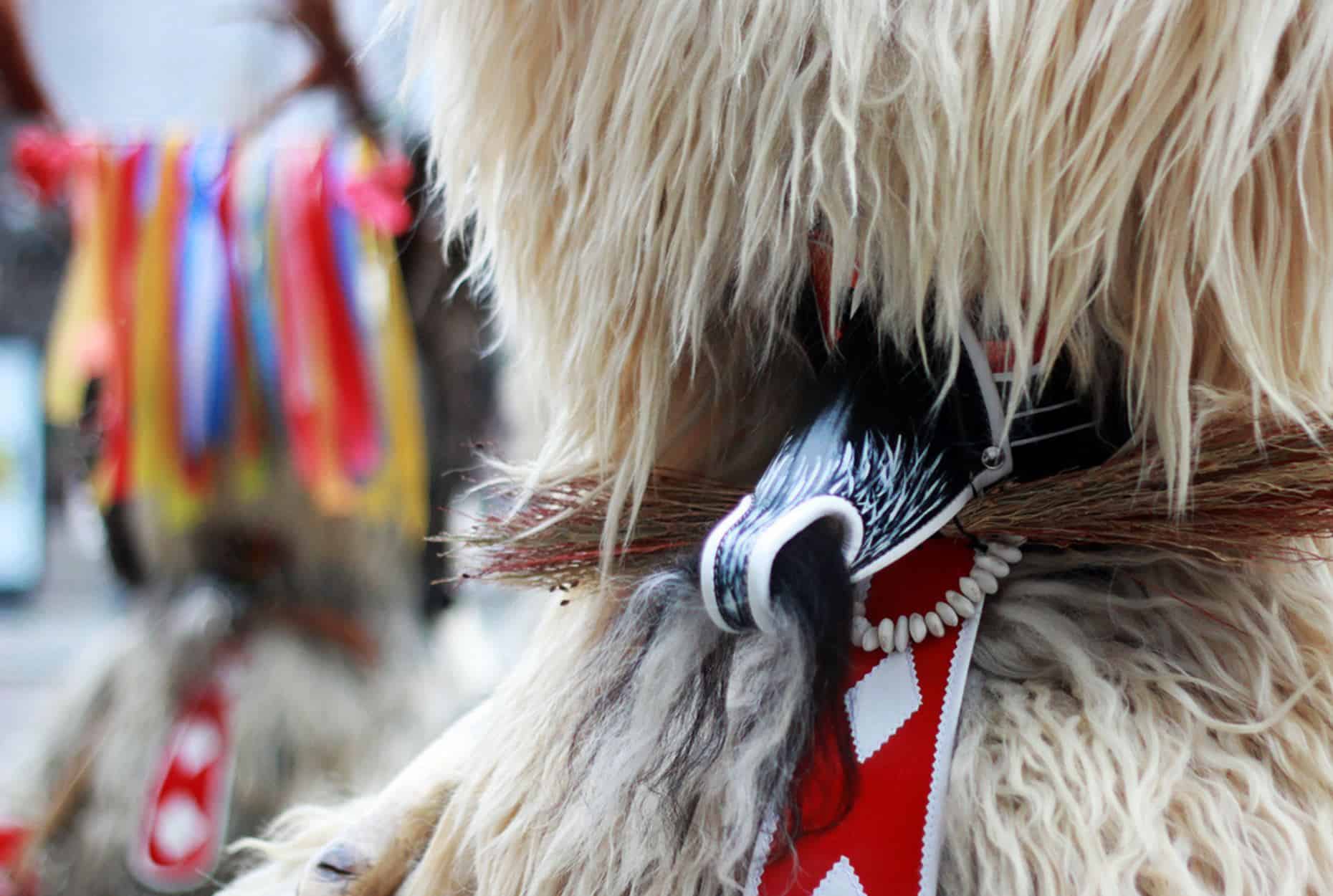





Kurent ali korant, kakor mu pravijo ljudje na podeželju, je najbolj priljubljen in množičen tradicionalni pustni lik. Njegov izvor ni popolnoma znan, a obstaja več domnev. So tiste povezane z ilirskokeltskim izročilom, ene omenjajo mitološke spremljevalce boginje Kibele, ki so jo častili na ozemlju rimske Poetovione v pozni antiki, nekatere kurenta enačijo s predniki Slovencev, spet druge z naseljevanjem Uskokov v 16. stoletju, …



Kurent ali korant, kakor mu pravijo ljudje na podeželju, je najbolj priljubljen in množičen tradicionalni pustni lik. Njegov izvor ni popolnoma znan, a obstaja več domnev. So tiste povezane z ilirskokeltskim izročilom, ene omenjajo mitološke spremljevalce boginje Kibele, ki so jo častili na ozemlju rimske Poetovione v pozni antiki, nekatere kurenta enačijo s predniki Slovencev, spet druge z naseljevanjem Uskokov v 16. stoletju, …

V kurente se je bilo včasih dovoljeno šemiti samo odraslim fantom. Vse od svečnice, 2. februarja, do pepelnične srede, so hodili v skupinah po domači in sosednjih vaseh, v spremstvu hudiča, ki je na domačiji ukradel kak par klobas. Njihov prihod k hiši je pomenil srečo celo prihajajoče leto. Če se je kurent povaljal po tleh, na dvorišču domačije, tisto leto sreče tam ni bilo. V drugi polovici 20. stoletja so pričeli v večjem številu zahajati na Ptuj, nastopati na Kurentovanju ter drugih organiziranih pustnih in folklornih prireditvah doma in na tujem.
Danes je okoli tisoč kurentov vključenih v številne podeželske in mestne skupine; največ je fantov in mož, nekaj tudi deklet in žena. Kurentije izdelujejo posebni redki mojstri. Čeprav je cena oprave dokaj visoka, je naročil iz leta v leto več, kar priča, da je kurent dediščina, ki pridobiva na popularnosti.
Vpis obhodov kurentov na Reprezentativni seznam nesnovne kulturne dediščine človeštva
Izjemno priznanje Unesca
Kurent – najbolj množičen pustni lik
Na svojem letnem zasedanju je Medvladni odbor za varovanje nesnovne kulturne dediščine Organizacije Združenih narodov za izobraževanje, znanost in kulturo (UNESCO) razglasil vpis obhodov kurentov na Reprezentativni seznam nesnovne kulturne dediščine človeštva.
Vpis obhodov kurentov na svetovni seznam predstavlja sklepni korak večletnih prizadevanj ptujske regije in Slovenije, zgodovinski dosežek pri ohranjanju nacionalne kulturne dediščine in doseganju še večje mednarodne prepoznavnosti pustnega lika kurenta na svetovnem zemljevidu, ki je že ponesel glas Ptuja in Slovenije v svet.
Ob razglasitvi na zasedanju je takratni župan Mestne občine Ptuj Miran Senčar povedal: »Najprej se želim zahvaliti vsem generacijam kurentov in korantov, ki že stoletja negujejo kulturno dediščino obhodov kurentov, ter vsem organizacijam in posameznikom, ki jim je z zahtevno pripravo nominacije uspelo obhode kurentov uvrstiti na UNESCO Reprezentativni seznam nesnovne kulturne dediščine človeštva. Zahvala gre tudi vsem etnografskim in karnevalskim skupinam, ki so nepogrešljiv del pustne tradicije na Ptujskem. V čast nam je, da so obhodi kurentov z vpisom na UNESCO Reprezentativni seznam nesnovne kulturne dediščine človeštva postali del svetovno pomembnih zakladov.«
Reprezentativni seznam nesnovne kulturne dediščine človeštva je eden izmed najvidnejših izrazov varovanja nesnovne kulturne dediščine v mednarodnem okolju, med nesnovno dediščino štejemo prakse, predstavitve, izraze, znanja, veščine in z njimi povezana orodja, predmete, izdelke in kulturne prostore, ki jih skupnosti, skupine in tudi posamezniki prepoznavajo kot del svoje kulturne dediščine. Po besedah podpredsednika Federacije evropskih karnevalskih mest in predsednika ptujskega Kurentovanja Branka Brumna je kurentovo obredje Ptuj in Slovenijo z vpisom na UNESCO seznam umestilo v zakladnico tisočletij kulturne dediščine in duhovnosti človeštva: »Etnografska kulturna dediščina predstavlja avtentično zibelko kulturne identitete in dediščine posameznika, mesta, naroda in človeštva. Zato so zaščita, skrb in ohranjanje te dediščine za prihodnje rodove ključnega pomena.«
Javni zavod Ptuj
Organizator Kurentovanja
Mestni trg 4,
SI-2250 Ptuj
T: +386 (0)2 779 60 11
pr@kurentovanje.net
info@kurentovanje.net
Kurentovanje
We firmly believe that the internet should be available and accessible to anyone, and are committed to providing a website that is accessible to the widest possible audience, regardless of circumstance and ability.
To fulfill this, we aim to adhere as strictly as possible to the World Wide Web Consortium’s (W3C) Web Content Accessibility Guidelines 2.1 (WCAG 2.1) at the AA level. These guidelines explain how to make web content accessible to people with a wide array of disabilities. Complying with those guidelines helps us ensure that the website is accessible to all people: blind people, people with motor impairments, visual impairment, cognitive disabilities, and more.
This website utilizes various technologies that are meant to make it as accessible as possible at all times. We utilize an accessibility interface that allows persons with specific disabilities to adjust the website’s UI (user interface) and design it to their personal needs.
Additionally, the website utilizes an AI-based application that runs in the background and optimizes its accessibility level constantly. This application remediates the website’s HTML, adapts Its functionality and behavior for screen-readers used by the blind users, and for keyboard functions used by individuals with motor impairments.
If you’ve found a malfunction or have ideas for improvement, we’ll be happy to hear from you. You can reach out to the website’s operators by using the following email
Our website implements the ARIA attributes (Accessible Rich Internet Applications) technique, alongside various different behavioral changes, to ensure blind users visiting with screen-readers are able to read, comprehend, and enjoy the website’s functions. As soon as a user with a screen-reader enters your site, they immediately receive a prompt to enter the Screen-Reader Profile so they can browse and operate your site effectively. Here’s how our website covers some of the most important screen-reader requirements, alongside console screenshots of code examples:
Screen-reader optimization: we run a background process that learns the website’s components from top to bottom, to ensure ongoing compliance even when updating the website. In this process, we provide screen-readers with meaningful data using the ARIA set of attributes. For example, we provide accurate form labels; descriptions for actionable icons (social media icons, search icons, cart icons, etc.); validation guidance for form inputs; element roles such as buttons, menus, modal dialogues (popups), and others. Additionally, the background process scans all the website’s images and provides an accurate and meaningful image-object-recognition-based description as an ALT (alternate text) tag for images that are not described. It will also extract texts that are embedded within the image, using an OCR (optical character recognition) technology. To turn on screen-reader adjustments at any time, users need only to press the Alt+1 keyboard combination. Screen-reader users also get automatic announcements to turn the Screen-reader mode on as soon as they enter the website.
These adjustments are compatible with all popular screen readers, including JAWS and NVDA.
Keyboard navigation optimization: The background process also adjusts the website’s HTML, and adds various behaviors using JavaScript code to make the website operable by the keyboard. This includes the ability to navigate the website using the Tab and Shift+Tab keys, operate dropdowns with the arrow keys, close them with Esc, trigger buttons and links using the Enter key, navigate between radio and checkbox elements using the arrow keys, and fill them in with the Spacebar or Enter key.Additionally, keyboard users will find quick-navigation and content-skip menus, available at any time by clicking Alt+1, or as the first elements of the site while navigating with the keyboard. The background process also handles triggered popups by moving the keyboard focus towards them as soon as they appear, and not allow the focus drift outside it.
Users can also use shortcuts such as “M” (menus), “H” (headings), “F” (forms), “B” (buttons), and “G” (graphics) to jump to specific elements.
We aim to support the widest array of browsers and assistive technologies as possible, so our users can choose the best fitting tools for them, with as few limitations as possible. Therefore, we have worked very hard to be able to support all major systems that comprise over 95% of the user market share including Google Chrome, Mozilla Firefox, Apple Safari, Opera and Microsoft Edge, JAWS and NVDA (screen readers).
Despite our very best efforts to allow anybody to adjust the website to their needs. There may still be pages or sections that are not fully accessible, are in the process of becoming accessible, or are lacking an adequate technological solution to make them accessible. Still, we are continually improving our accessibility, adding, updating and improving its options and features, and developing and adopting new technologies. All this is meant to reach the optimal level of accessibility, following technological advancements. For any assistance, please reach out to